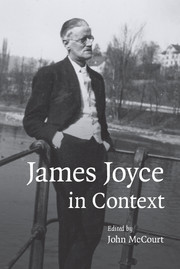Book contents
- Frontmatter
- Contents
- Notes on contributors
- Preface
- List of abbreviations
- PART I LIFE AND WORKS
- PART II THEORY AND CRITICAL RECEPTION
- PART III HISTORICAL AND CULTURAL CONTEXTS
- 14 Being in Joyce's world
- 15 Dublin
- 16 Nineteenth-century lyric nationalism
- 17 The Irish Revival
- 18 The English literary tradition
- 19 Paris
- 20 Trieste
- 21 Greek and Roman themes
- 22 Medicine
- 23 Modernisms
- 24 Music
- 25 Irish and European politics: nationalism, socialism, empire
- 26 Newspapers and popular culture
- 27 Language and languages
- 28 Philosophy
- 29 Religion
- 30 Science
- 31 Cinema
- 32 Sex
- Further reading
- Index
16 - Nineteenth-century lyric nationalism
Published online by Cambridge University Press: 14 July 2009
- Frontmatter
- Contents
- Notes on contributors
- Preface
- List of abbreviations
- PART I LIFE AND WORKS
- PART II THEORY AND CRITICAL RECEPTION
- PART III HISTORICAL AND CULTURAL CONTEXTS
- 14 Being in Joyce's world
- 15 Dublin
- 16 Nineteenth-century lyric nationalism
- 17 The Irish Revival
- 18 The English literary tradition
- 19 Paris
- 20 Trieste
- 21 Greek and Roman themes
- 22 Medicine
- 23 Modernisms
- 24 Music
- 25 Irish and European politics: nationalism, socialism, empire
- 26 Newspapers and popular culture
- 27 Language and languages
- 28 Philosophy
- 29 Religion
- 30 Science
- 31 Cinema
- 32 Sex
- Further reading
- Index
Summary
James Joyce spent his formative years in the second city of Victoria's British Empire. For all that his schooldays were imprinted with the Jesuit experiment with the English public school that was Clongowes Wood College, his childhood and youth were dominated by a Catholic nationalism seeking the self-determination denied by a British policy which thought it had solved its Irish problem by welcoming Ireland fully into the United Kingdom in 1801. After the defeat of the United Irishmen in 1798, the Union made Ireland English in language and law and thus supposedly a full partner in the project of Empire. However, the successful campaign for Catholic Emancipation in 1829, and the catastrophe of the Famine of the 1840s, led a majority of Irish politicians to campaign against this assimilation. The popular nationalism of the tradition of Daniel O'Connell initially pursued separatism on the grounds of sectarian difference – Ireland's Catholicism had survived the Reformation and subsequent attempts to impose it by a British Protestant state and landowning class. But the nationalist claim was also founded on a new conception of the Irish past, in which a persisting ancient Gaelic culture and language would act as the basis for the formation of one of the non-imperial and culturally distinct states that the modern European ideology of nationalism sought to promote.
- Type
- Chapter
- Information
- James Joyce in Context , pp. 184 - 194Publisher: Cambridge University PressPrint publication year: 2009



